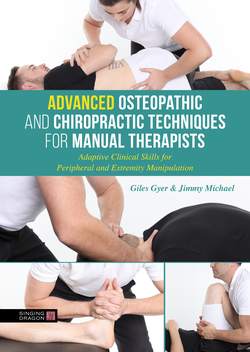Читать книгу Advanced Osteopathic and Chiropractic Techniques for Manual Therapists - Giles Gyer - Страница 7
На сайте Литреса книга снята с продажи.
Neurophysiological effects of spinal manipulation
ОглавлениеMany authors have long postulated that spinal manipulation exerts its therapeutic effects by means of a number of neurophysiological mechanisms working on their own or in combination (Bialosky et al. 2008a, 2009; Pickar 2002). These mechanisms involve complex interactions between the peripheral nervous system and the central nervous system, and have been thought to be set in motion when spinal manipulation activates paraspinal sensory afferents (Pickar and Bolton 2012). The activation of sensory neurons is presumed to occur either during the manoeuvre itself and/or because of changes in spinal biomechanics. These paraspinal sensory inputs are assumed to alter neural integration either by directly influencing reflex activity and/or by affecting central neural integration within motor, nociceptive and possibly autonomic neuronal pools (Pickar 2002). However, since current biomechanical studies of spinal manipulation are unable to observe the changes occurring in the brain following the therapy – for example, how sensory afferent neurons produce neurophysiological effects by interacting with those in the central nervous system – the validity and relevance of theorised neurophysiological mechanisms in relation to therapeutic outcomes remains unclear. Implications for specific neural mechanisms of manipulation are suggested from associated neurophysiological responses, which have been observed in mechanistic studies.
Over the past decades, a number of specific and non-specific neural effects of spinal manipulation have been reported, including increased afferent discharge (Pickar and Bolton 2012), central motor excitability (Pickar 2002), alterations in pain processing (Lelic et al. 2016), reduction of temporal summation (Randoll et al. 2017), stimulation of the autonomic nervous system (Sampath et al. 2015), lessening of pain perception (Bialosky et al. 2008b) and many more. These neural responses collectively implicate mechanisms mediated by the nervous system. Figure 1.1 presents a new theoretical model that illustrates the proposed neurophysiological effects of spinal manipulation based on the findings of current mechanistic literature. This model is heavily inspired by the comprehensive model presented by Bialosky and colleagues (2009), which was drawn interpreting the literature of several forms of manual therapy including nerve-based, mobilisation, manipulation and message therapies; hence, its relevance to spinal manipulation alone is unclear. The theoretical model we propose herein is diagrammed including only the literature on HVLA thrust manipulation.
Figure 1.1. Neurophysiological and neurochemical effects of spinal manipulation
